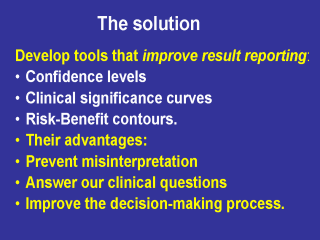| front |1 |2 |3 |4 |5 |6 |7 |8 |9 |10 |11 |12 |13 |14 |15 |16 |17 |18 |19 |20 |21 |22 |23 |24 |25 |26 |27 |28 |29 |30 |31 |32 |33 |34 |35 |review |
 |
New tools such as confidence levels, clinical significance curves, and risk-benefit contours have been postulated as potentially improving result reporting (Ref 1, 16-19). These tools, which are based on confidence intervals, can help prevent result misinterpretation, answer the questions we have of the data, and improve decision-making based on study results. 1. T.P. Shakespeare, V.J. Gebski, M.J. Veness, J. Simes, Improving interpretation of clinical studies by use of confidence levels, clinical significance curves, and risk-benefit contours, Lancet 357 (2001) 1349–53. 16. P. Landais, J-P. Daures, Clinical trials, immunosuppression and renal transplantation: new trends in design and analysis, Pediatr. Nephrol. 17 (2002) 573-584. 17. G. Bouvenot, P. Villani, P. Ambrosi, Critical review of the publication of a clinical trial, Presse. Med. 31 (2002) 1061-1068. 18. G. Bouvenot. How to minimize the therapeutic risk, Rev. Med. Interne. 22 (2001) 1237-1243. 19. A. Hernandez Jerez, From case report to epidemiological evidence of causality in biomedical research, Arbor 171 (2002) 589-608. |